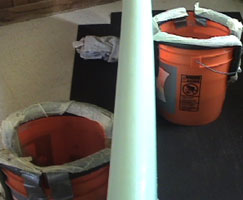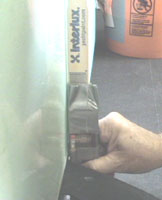| How to Build Your First Surfboard by Stephen Pirsch |
|
HOME
This is your site. It is not biased by any direct advertising and no money is accepted for any links shown. It is made for you and supported by you. PLEASE DONATE!
HALL OF FAME Mark Sadler |
DESIGN Deciding on shape is probably the most important part of making a surfboard. Thrusters and longboards have their place, but many surfers are riding designs which do not maximize the fun possible on the type of waves being ridden. Often it seems the image a surfer thinks he will portray is affecting his design decision. The best way to simplify the decision is to ride as many different surfboards as possible. This is important. It is unlikely you will ever know what is best suited for you if you do not experiment. One hour surfing a different board is better than ten hours reading about design, or listening to opinions. Most surfers will let you try their board for a few minutes. Try your friends' boards or rentals. Find one you like, then copy it or modify it. I love seeing all types of surfboards, but I feel that the biggest design drawback is simply building too small. This appears to be a common problem with all types of surfboards. My friends and I are happier surfers now that we are designing for the average conditions of ourselves and our home break. Many people quit trying to surf simply because their board is too hard to paddle and catch waves. Generally accepted truths about surfboard design:
If new to surfing, ride mostly small, or slow waves, or just enjoy early wave entry gliding, use the following guidelines: 1/2" thickness for each 25 lb. of body wt. and 2' longer than height. To be more exact use: .50 cubic feet of foam per 25 lb. of body weight (the US Blanks, and Clark Foam catalog has the cubic foot numbers for each blank for free online at www.foamez.com ). For example; a 150lb. surfer divided by 25 equals 6. 6 times .50 = 3 cubic feet of foam. Add at least 5% (1/4") for shaping losses which brings the example to 3.15 cubic feet. Simply look at the displacement number (cubic feet of foam) in the catalog for the blank with a close number. If you pick a blank within 10% of your number you will have a good wave catcher. Remember to add 10 lbs to your weight if you wear a wetsuit often when surfing. These guidelines are maximums. More is not likely better in this case. A board designed using the math above gives a huge advantage in crowded conditions, by allowing early wave entry. There are many alternatives to the standard thruster and longboard shapes. Instead of using a longer blank you could use one that is shorter, wider and, thicker. One & one half inch in width or, one quarter inch in thickness is approximately equal to six inches in length (width and/or thickness through the entire blank, not just the center). A board 6.5' x 22" x 2.25" will catch waves about the same as a board 7' x 20.5" x 2.25". A board 8.5' x 23 " x 3.25" will catch waves about the same as a board 9 x 23" x 3" . A shorter board will turn easier and go from turning to planning faster than a longer board. If you cannot decide what rocker to use, consider five inches at
the nose tip, and two inches at the tail end. An easy way
to form a useful rocker on any surfboard is: Divide by 2.5.
Divide the total nose end or tail end rocker by 2.5. This
will give the rocker at one foot from the nose or tail ends.
Dividing this new number by 2.5 will give the rocker two foot from
the nose and tail ends. Example: A blank (with all its measurements) can be choosen from the Clark Foam catalog and copied with polystyrene block foam - this is the hard, cheap way. See POLYSTYRENE. Note: Although Clark Foam is out of buisness, the old Clark Foam catalog is an excellent design resource. Also; see the US Blanks catalog - both available at Foamez. The easiest way to shape a surfboard is to pick the exact blank needed. Anyone who orders a roughly shaped polyurethane blank, and has to cut the entire rail with a saw, or plane in different rocker, is probably working much harder than is needed. Unless you are sure the blank will not have to be modified (blank is exactly the shape you want), make a template (as outlined below) on 30 lb. roofing felt, or trace the board outline directly on the blank - the left over roofing felt will be used later to protect the floor when glassing. Making a template will allow mistakes on a very cheap surface, instead of an expensive blank. Also, a template will make it very easy to exactly duplicate, or slightly modify an earlier board. Resist drawing numerous lines, hoping to visualize what looks right. Make an outline template by doing the following:
A rocker template can be made by doing the following:
If the above method is not practical, get measurements (or use your own) at 3, 6, 9, 12, 18, and 24" for the last two feet of nose and tail, and every one foot for the rest of the board length. Do the following:
Note: If you know the blank will not need to be modified (recommended), these steps can be skipped. Although there are many good reasons for making the measurements below, I urge tracing the outline and rocker of an existing board on 30 lb. roofing felt (as mentioned above), or directly on to the foam blank. If measurements are possible , a piece of roofing felt can simply be taken where the measurements would have been made, and traced instead. Tracing is faster, easier, and less prone to errors. If you must measure, see Figure 1, 1a, 2, 3, and the directions which follow. Figure 1 Figure 1a
Figure 2 Figure 3
If you insist on measuring try these steps:
If choosing a roughly preshaped, polyurethane blank, pick the blank and rocker that is the closest to your desired measurements. The less foam you shape off, the stronger your board will be, the less work you will have to do, and less errors you will make. Note: There are now two versions of polyurethane; one which is uniform throughout (MDI), and another which has a crust (dense 1/8" outer layer) - (TDI) Polystyrene block foam will allow a design that would be impossible with polyurethane foam. In contrast to TDI polyurethane, polystyrene foam is the same density throughout, so buying oversize polystyrene block foam is ok, and advisable. Combine the smallest stringer possible, with more cloth in the laminate. Epoxy glue joints, and stringer less blanks work well also, if the amount of cloth in the laminate is increased. Break tests done on surfboards indicate a surfboard with a light stringer (1/12" is light) and heavy laminate is stronger than a surfboard of the same weight with a heavy stringer and light laminate. Multiple light stringers or epoxy glue joints are stronger than an equivalent large stringer. Check www.foamez.com , www.fiberglasssupply.com, and www.surfsource.net for availability of polyurethane and polystyrene blanks. If available, you can save money by having a blank shipped, and held at the central shipping warehouse (to be picked up by you) in your city, rather than delivered to your home. Polystyrene block foam is available in all large cities. Please do not short cut what is probably the most important part of board building; your design. It is amazing the hours of sanding and rubbing builders are willing to endure for a glossy finish, while stubbornly refusing to think for one minute about design. Ask yourself, "what are the average surfing conditions of my home break, and what design will best allow me to take advantage of those conditions?" Ride a lot of boards before you design!
|



